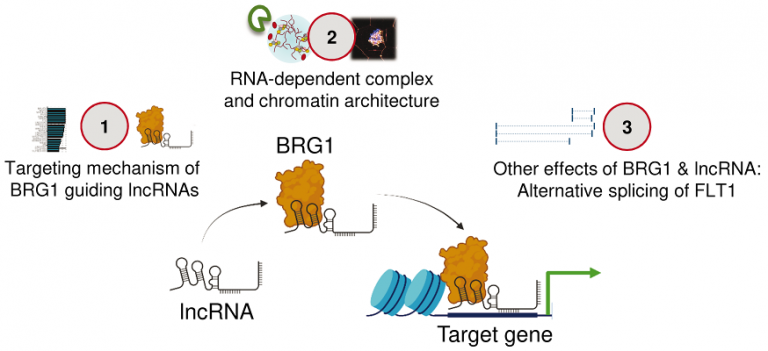

Research Details
-
Project Leaders
Dr. Phillip Grote
Georg-Speyer-Haus
Institute for Tumor Biology
and Experimental Therapy
ph.grote@georg-speyer-haus.de
Prof. Dr. Karl-Ludwig Laugwitz
Department of Cardiology
TUM University Hospital (Klinikum rechts der Isar)
laugwitz@tum.de -
Research Staff
Dr. Tamer Ali (Postdoc)
t.ali@georg-speyer-haus.de
Yi-Husan Lin (PhD student)
y.lin@georg-speyer-haus.de
Sandra Rogala (PhD student)
s.rogala@georg-speyer-haus.de
Sophie Zengerle (PhD student)
sophie.zengerle@tum.de
The heart is the first organ that forms during embryogenesis and its function heavily depends on the proper spatio-temporal patterning and assembly of multiple progenitor cell populations that ultimately give rise to the diverse cell types within the specialized cardiac structures of the heart. Long non-coding RNAs (lncRNAs) constitute an important component of regulatory elements that control cell fate specification and differentiation. In the past, lncRNA research focused mainly on the transcriptional control of gene regulatory networks. However, in recent years lncRNAs were shown to also play a role in the regulation of alternative splicing events and thereby modulate developmental outcomes and homeostasis. Genome wide analysis of alternative splicing in cancer identified that the CTCF (CCCTC-binding factor) genome organizing factor binds to upstream introns of alternatively spliced exons and thereby contributes to alternative splicing events. Here, we describe and functionally characterize the lncRNA Platr26, which binds CTCF and promotes cardiac-specific alternative splicing of the integrin coding gene Itga6. CTCF binds upstream of the cardiac-specific exon 25 of Itga6, and the deletion of its DNA binding site has similar effects as loss of the lncRNA. Our results support a novel role of lncRNAs to promote site-specific alternative splicing via binding to CTCF in cardiac cells. In this project, we set out to determine the mechanisms of this specific splicing event regulated by the lncRNA/CTCF axis in models of human and mouse cardiogenesis and expand our analysis to human disease relevant variations. Recently, we established a close collaboration with our partner site in Yale of the U.S. Pediatric Cardiac Genomics Consortium (PCGC) to identify congenital heart disease relevant splicing events. Accordingly, we plan to analyze them in genetic models of human iPSC-derived 3D heart structures ex vivo and embryonic mouse cardiogenesis in vivo. A deep molecular understanding of gene regulatory programs and differentiation during embryonic heart development is crucial for advancing our knowledge in the diagnostics and treatment of congenital cardiac malformations.





